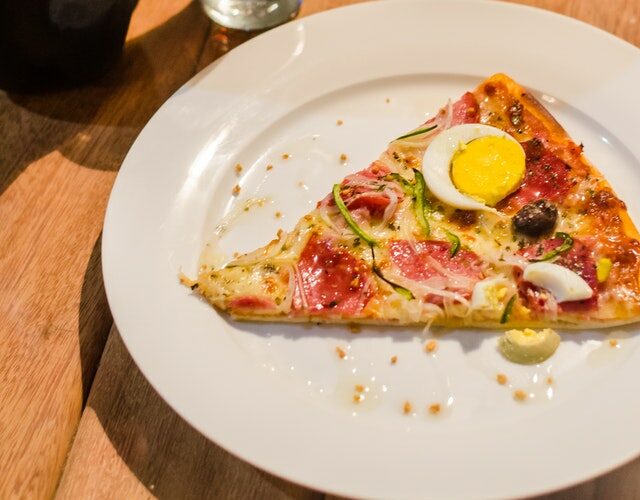Have you attended a pizza party lately? Has your firm been trying to seduce you back into the office with the promise of under-seasoned jarred sauce and crust? Have you ever stared down a tiny tub of garlic butter sauce wondering wtf you’re doing with your life? Then this piece (heh) is for you.
Wikipedia describes a pizza party as:
A pizza party is a social gathering at which pizza is served.
Typically, a pizza that is 10 to 14 inches wide will feed two people. Since pizzas can include a very wide variety of toppings, one particular type of pizza party allows the guests to create their own custom-made pizza, using a selection of ingredients from among the toppings provided by the party’s host.
When a pizza party does not include any custom-made pizzas, and the particular preferences of the guests are unknown, it is common to include at least one plain cheese-only and/or vegetable-only pizza for people who are averse to meats or other available toppings.
You’ll note there is absolutely no mention of pizza parties as an acceptable substitute for compensation, surely that’s just an oversight on the part of diligent Wikipedia editors.
You likely experienced your first pizza party some time in elementary school, often toward the end of the year to celebrate the closing of the school year. Unless you were a friendless weirdo, you likely also attended pizza parties as part of your friends’ birthdays though those don’t really count because they aren’t technically pizza parties but rather a birthday party with pizza as a bonus. The Wikipedia definition contradicts this, but whatever, Wikipedia isn’t a reliable source as anyone on the internet knows.
But how did corporate America get the idea to offer pizza parties in lieu of money? When did pizza establish itself as a corporate reward far more valuable than a few extra digits in a payroll ledger? And why?
ezCater suggests that the pizza party inspires nostalgia for better, more carefree times when we didn’t have to worry about bills or clients or greying hair:
Everyone loves a pizza party. It all starts when we’re kids. Whether your class did well on a test, your team won the game, or your friend had a birthday, the pizza party was always the go-to choice to mark the happy event. As you get older, there’s Friday-night pizza, dorm room pizza, thanks-for-helping-me-move pizza, and countless other pizza-themed celebrations.
With all those good-time feelings attached to the pizza parties of the past, it’s no wonder that the office pizza party became such a staple. Pizza just makes people smile.
Ah yes, the smiling. Just look at these radiant grimaces smiles from a recent Marcum pizza party:

At some point, some CEO somewhere got the idea to create a National Pizza Party Day which is celebrated yearly on the third Friday in May, not to be confused with National Pizza Day which is every February 9th. Mark your calendars for the next eight National Pizza Party Days, surely some admin in your office in charge of ordering stacks of ‘za to keep you all from revolting already has.
National Pizza Party Day dates
| 19 May 2023 |
| 17 May 2024 |
| 16 May 2025 |
| 15 May 2026 |
| 21 May 2027 |
| 19 May 2028 |
| 18 May 2029 |
| 17 May 2030 |
The problem with pizza parties — beyond the obvious “this company is cheap” subtext — is that any positive engagement gained via cheese and carbs is generally short-lived. In other words, pizza parties and their equally obnoxious cousins “donuts in the breakroom” and “firm-branded travel mugs” do inspire positive feelings toward the company but only for short time. From DC management consulting group The Clearing:
Offering free lunch is an example of what Harvard Business Review (HBR) calls an adrenaline shot: a short-term, employee engagement effort designed to temporarily boost employee satisfaction. Adrenaline shots feel nice in the moment but provide no lasting impact on the overall, long-term employee experience (EX). According to HBR, “when organizations make real gains…they’re going beyond what engagement scores are telling them to do in the moment… creating a place where people want, not just need, to work each day.” Only when organizations go beyond short-term satisfaction boosters can they reap the rewards of positive EX.

That harsh truth of pizza parties’ temporary goodwill isn’t stopping the brain trusts of cheap employers around the country from dangling pizza parties in front of remote staff as we move into the post-COVID future. With people returning to the office by choice or by force, some companies are trying to lure staff back to their sacred leased ground with pizza. Because if they actually paid people more money, said people would be able to afford more pizzas in the privacy of their own homes and not feel a sense of hunger FOMO at the prospect of room temperature office pizza. But then that defeats the whole purpose, doesn’t it? Plus there’s the lure of deductions when it comes to in-person feeding, surely something top of mind for accounting firm partners looking for cheap easy ways to reward their people that don’t involve dipping too deep into those record-breaking revenues.
The whole “food as a reward for working” thing seems to have roots in the company store of the 19th and early 20th centuries. Company stores popped up in mining towns and served as a Walmart of sorts, miners would be paid in scrip which then could be used to purchase goods from these company stores. All their goods. Clothes, coffee, groceries, even caskets. Let’s just be grateful accounting firms pay you enough for you to afford a decent rotation of blue button-up shirts and a cremation.

Some of you — especially Fallout 76 players, all three of you — may be familiar with old 16 Tons song:
You load 16 tons, what do you get?
Another day older and deeper in debt
St. Peter, don’t you call me ’cause I can’t go
I owe my soul to the company store
While we can’t say for sure when exactly the pizza party elbowed its way into offices everywhere, we can pretty safely say the concept goes way back to the early 20th century, shortly after capitalist genius Henry Ford ushered in the 40-hour workweek by coming to the brilliant realization that workers tend to buy more stuff when they get paid fairly and are given some time off. “Leisure is an indispensable ingredient in a growing consumer market because working people need to have enough free time to find uses for consumer products, including automobiles,” he said in a 1926 interview. It was then that companies could no longer exploit 100-hour workweeks out of workers and had to come up with some other scheme through which to signal appreciation but in such a way as to not steal from profits.
God forbid people just get more money.

For you old-timers out there, did they have pizza parties in the ’90s? ’80s? Check in and share some war stories.



